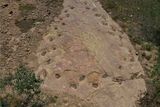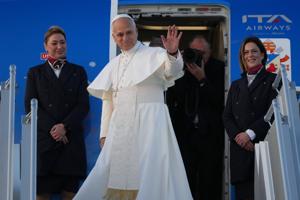Fossilized Footprints Uncover Sauropod’s Rare Turning Behavior

A recent analysis of fossilized footprints, dating back approximately 150 million years, has revealed the unexpected agility of a sauropod dinosaur. This study, published in the journal Geomatics, documents a unique trackway measuring about 313 feet long, featuring over 130 footprints. It represents the largest and tightest trackway recorded for any sauropod dinosaur to date.
According to Anthony Romilio, a paleontologist at the University of Queensland and one of the study’s authors, the trackway is distinctive because it forms a complete loop. “While we may never know why this dinosaur curved back on itself, the trackway preserves an extremely rare opportunity to study how a giant sauropod handled a tight, looping turn before resuming its original direction,” Romilio explained in a press release.
Insights into Sauropod Movement
The footprints were discovered at the West Gold Hill Dinosaur Tracksite in Ouray County, Colorado. During the late Jurassic period, more than 20 species of sauropods roamed North America, including well-known giants like the Diplodocus and Apatosaurus. Although these dinosaurs were not known for their agility, the newly analyzed trackway offers insights into their movement patterns.
The research team faced challenges in documenting the footprints due to the size of the trackway. Paul Murphey, another author and paleontologist at the San Diego Natural History Museum, noted, “It has been challenging to document these footprints from the ground because of the size of the trackway.” To overcome this obstacle, the researchers utilized drone technology to capture aerial images of the site. These images were then converted into a high-resolution virtual model, allowing for a detailed analysis of the sauropod’s movements.
Discovering Unique Patterns
The study revealed that the sauropod initially walked northeast before executing a counterclockwise turn. “It was clear from the start that this animal began walking toward the northeast, completed a full loop, and then finished facing the same direction again,” Romilio stated. Additionally, subtle variations in the width of the footprints were observed, indicating a change in the sauropod’s stride.
Romilio elaborated, “One of the clearest patterns was a variation in the width between left and right footprints, shifting from quite narrow to distinctly wide.” This finding suggests that the footprint width can naturally change as a dinosaur moves, which highlights the importance of analyzing longer trackways for a more accurate understanding of their walking style.
Interestingly, the researchers also discovered that the length of the sauropod’s steps varied by about 4 inches between its left and right sides. This discrepancy raises the possibility that the dinosaur may have had a limp or exhibited a strong preference for certain legs.
The study emphasizes the potential of advanced imaging and modeling techniques in the analysis of dinosaur trackways. Romilio remarked, “There are many long dinosaur trackways around the world where this method could be applied to extract behavioral information that was previously inaccessible.”
As researchers continue to explore these ancient traces, the findings shed light on the locomotion of one of the largest creatures to ever walk the Earth. The insights gained from this study not only enhance our understanding of sauropod behavior but also pave the way for future research into the movement patterns of other prehistoric animals.






